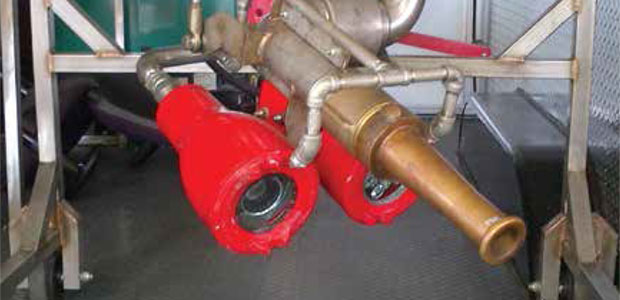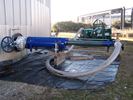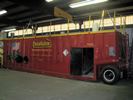
Minimizing CSE Leads to Increased Safety and Efficiency
Several cleaning technologies are available. They greatly reduce the risk of slips and falls and equipment injuries from working inside tanks where water or cleaning solutions collect at the bottom.
- By Darin Hauck
- Aug 01, 2013
The petroleum and chemical industries rely heavily on storage, production, and process tanks. The condition of these tanks affects product quality, safety, and efficiency. As a result, frequent maintenance operations must be performed. This maintenance often involves the need for Confined Space Entry (CSE), which has inherent safety risks and requires careful planning and execution.
This paper will discuss some of these safety issues and also present some alternative tank cleaning methodologies that can minimize or eliminate CSE.
Confined Space Procedures
Not all confined spaces are created equal. Some, like open air manholes, pits, and storage bins or tanks used for inert materials, are relatively straightforward. However, a different group of containers, classified by the Occupational Safety and Health Administration as "permit-required confined spaces" (www.osha.gov/SLTC/confinedspaces/index.html), demands a higher level of safety planning. OSHA defines a permit space as any confined space that "contains or has the potential to contain a hazardous atmosphere; contains a material that has the potential to engulf an entrant; has walls that converge inward or floors that slope downward and taper into a smaller area which could trap or asphyxiate an entrant; or contains any other recognized safety or health hazard, such as unguarded machinery, exposed live wires, or open floor holes."
This definition means that virtually every large container used in support of petroleum, chemical, and many industrial operations is a permit-required confined space. As a result, companies such as Clean Harbors that perform CSE cleaning, maintenance, or repairs must adhere to OSHA guidelines for permit-required confined space procedures and provide extensive training for technicians.
All permit-required spaces require the atmosphere to be ventilated prior to entry. This requirement is based on the fact that the atmosphere within these types of spaces may contain various toxins that require technicians entering the space to utilize personal protective equipment, including some form of respiratory protection.
Safety standards require comprehensive planning and preparation. The plant operator's and the contractor's safety practices must be reconciled with each other. Generally, the highest standard is applied to the project.
The plant operator locks out the equipment, blinds and bleeds the lines, and then blinds the equipment. (Blinding a tank is sealing the inputs and outputs, while blinding a pipe is capping it.) The operator ventilates and tests the space. Once the area is declared safe and the scope of work is defined, the entry permit is issued.
This is followed by a review of the permit by the plant operator and the contractor(s) in a Pre-entry Safety Meeting to discuss all aspects of the project, including rescue plans. The plant's rescue team is alerted and participates because they are typically responsible for the response. If the plant operator does not have rescue team resources, a third party, or in some cases the contractor, has the capability to provide rescue services.
 The confined space is then turned over to the contractor, or in some cases contractors, including scaffolding contractors if it is a large, multi-function project. In the case of multiple contractors, each contractor would receive a separate permit and project coordination would be handled by the plant operator.
Manning the CSE is in itself complex. CSE requires an entry supervisor, as well as an attendant (monitor) stationed outside of the vessel at each access point who is in constant communication visually, verbally, or by radio with his or her assigned technician (entrant) while that person is working in the vessel. Contractors often bring in their own atmosphere-testing equipment to continuously monitor conditions throughout the project.
The confined space is then turned over to the contractor, or in some cases contractors, including scaffolding contractors if it is a large, multi-function project. In the case of multiple contractors, each contractor would receive a separate permit and project coordination would be handled by the plant operator.
Manning the CSE is in itself complex. CSE requires an entry supervisor, as well as an attendant (monitor) stationed outside of the vessel at each access point who is in constant communication visually, verbally, or by radio with his or her assigned technician (entrant) while that person is working in the vessel. Contractors often bring in their own atmosphere-testing equipment to continuously monitor conditions throughout the project.
In the case of Clean Harbors, all of this preparation is necessary so that an entrant or entrants can work in the confined space using pressure washer lances and vacuums or shovels to remove the resulting slurry. In addition to working in a hazardous atmosphere, entrants are put at risk because of the challenges of working in a confined space, the potential for slips and falls from slippery surfaces caused by the cleaning process itself, as well as accidents resulting from using the equipment.
 Often, as we go through the planning process, we recognize that there are alternative approaches that can eliminate or at least greatly reduce the need for CSE. Whenever possible, we recommend these approaches to plant operators because of the enhanced safety, efficiency, and, in many cases, cost savings.
Often, as we go through the planning process, we recognize that there are alternative approaches that can eliminate or at least greatly reduce the need for CSE. Whenever possible, we recommend these approaches to plant operators because of the enhanced safety, efficiency, and, in many cases, cost savings.
Alternatives to CSE
Over the years, several tank cleaning approaches have been developed that substitute entry with the use of higher pressure, remotely controlled technologies. Following is a sampling of some of the technologies that Clean Harbors recommends to our customers when appropriate:
- Orbital tank cleaner. The orbital tank cleaner is a small, multi-nozzle water jet that is inserted into a tank through a manway and uses hydraulic pressure of up to 1000 psi. The jet nozzle rotates 360 degrees, enabling it to contact and flush the entire interior surface. The orbital tank cleaner is connected by a hose to a pump truck manned by a remote operator; it supplies water and/or surfactants and neutralizing agents. Because the tank remains essentially sealed, atmospheric emissions are controlled throughout the process. Orbital tank cleaners can be used in large tanks with minimal baffles or weirs. They are highly efficient and effective in tanks that would normally require scaffolding for cleaning operations. The combination of pressure and solvents dissolves and neutralizes the solid buildup, enabling the materials to be flushed from the tank floor for removal and processing.
- Manway cannon. A Remote Operated Mounted Manway Cannon is typically mounted to a side entry manway about 3-4 feet from the bottom of the tank to break up sludge and solids that have collected on the bottom surface. It is mounted using a sealing flange on the manway opening. The sealed tank controls the release of VOCs in compliance with emission standards. Manway cannons typically work well in tanks of 50-150 feet in diameter that do not have weirs or other internal obstructions. As with all of these CSE alternatives, the manway cannon is operated from a remote command center located outside the tank. The cannon head includes a light and video recording camera to help the operator control the cleaning process. The operator is able to direct the cannon on an X, Y axis. Typically, one manway cannon is assigned to each tank, however, it may have to be moved to more than one manway in order to reach all tank locations and complete the project. Orbital tank cleaning is often used to finish the project. The resulting solids and sludge are flushed from the tank floor.
- Tank sweep. Tank sweep is an alternate way to attack large volumes of sludge and solids in tank bottoms. Tank sweeps put out a large volume, 2000 gpm at 150 pounds pressure. Also mounted through manways that are low on the sidewalls of large tanks, multiple tank sweeps are used to create a vortex that rotates cleaning solution around the bottom of the tank, creating a slurry that can be pumped out. Tank sweeps are not designed to clean the entire tank, so they are often used along with other cleaning technologies, such as the orbital cleaning nozzles.
- PIC. The PIC approach is another technology that cleans solids and sludge from the bottom of tanks. In this case, multiple pipes are inserted through low manways to suck the residue from the bottom of the tank. The process works by injecting a cleaning solution into the tank that creates a sludge that can then be siphoned back up through the pipes for processing. Picture straws inserted into the bottom of the tank. As with the tank sweep, the PIC system does not reach the upper levels of the tank, so other methods must be employed if the entire tank is to be cleaned.
All of these technologies have the objective of minimizing CSE time and significantly decreasing the human risk of placing entrants into dangerous atmospheres and work environments. These technologies also greatly reduce the risk of slips and falls and equipment injuries from working inside tanks where water or cleaning solutions are collected at the bottom.
These technologies are not an excuse to relax safety standards in any way; however, they can often expedite the process by eliminating the need for scaffolding as well as safety systems necessary to support human entry. For these reasons and because these alternative approaches can often save time and can also be cost effective, they should be considered whenever practical.
This article originally appeared in the August 2013 issue of Occupational Health & Safety.